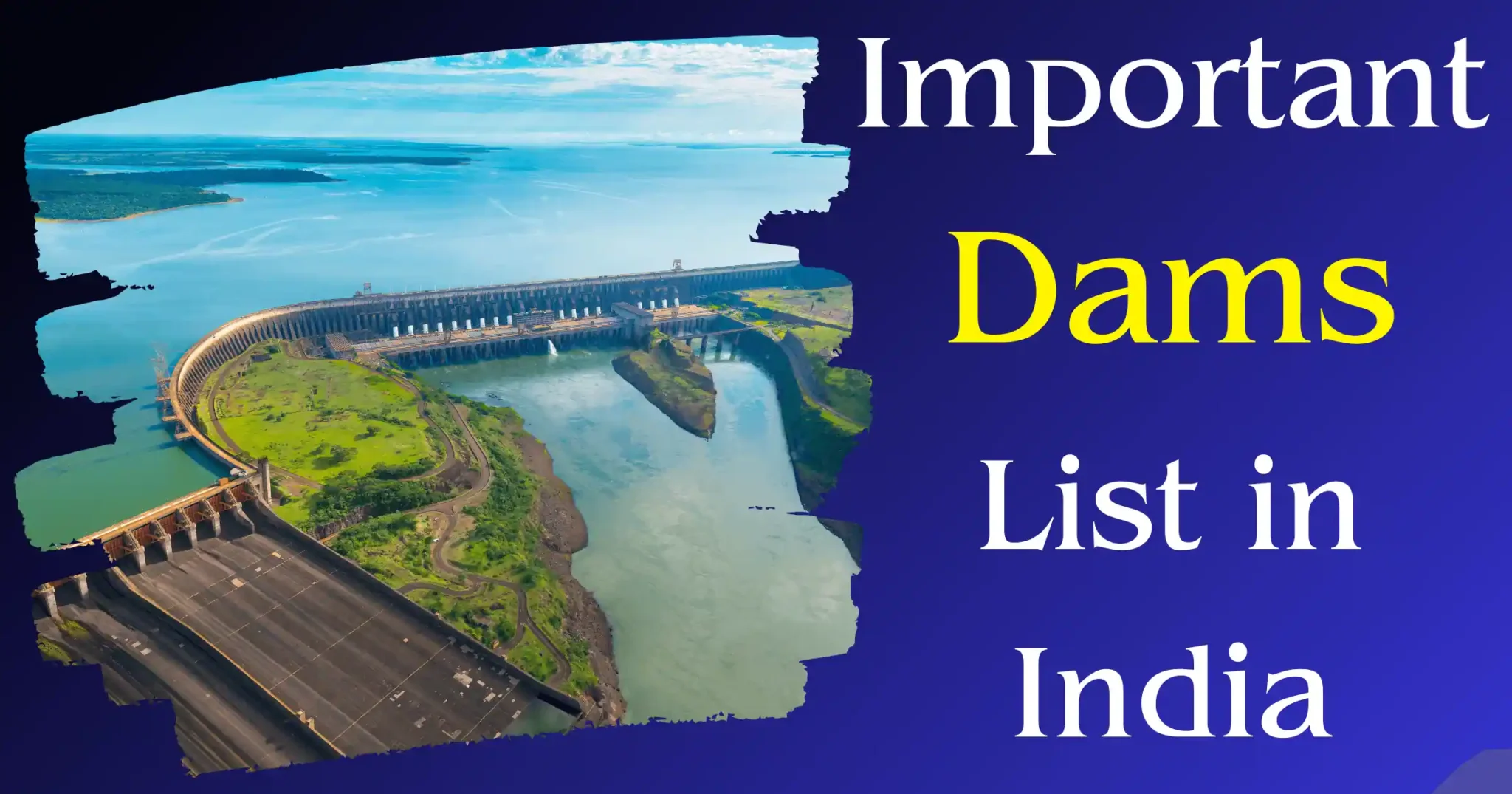A dam is a barrier built across a river or stream for many purposes like irrigation, flood control, and generation of electricity. It contains and controls the flow of water, creating a reservoir or lake. Dams are constructed for various purposes, such as water supply, irrigation, flood control, hydropower generation, and recreation. They are typically made of concrete, earth, or rock.
Dams may have features like spillways and gates. These features are used to manage the water levels and flow. Dams can have significant impacts on the surrounding environment and ecosystems. Construction of the dam requires careful planning and management. There are many important rivers and dams in India. These rivers and dams are the heart of the country’s agricultural growth.
Major Types of Important Dams in India
1. Gravity Dams:
Gravity dams are constructed using concrete. They rely on their weight. It helps resist the horizontal pressure of the water behind them. These dams are made in locations with solid bedrock and can range in height from low to very high.
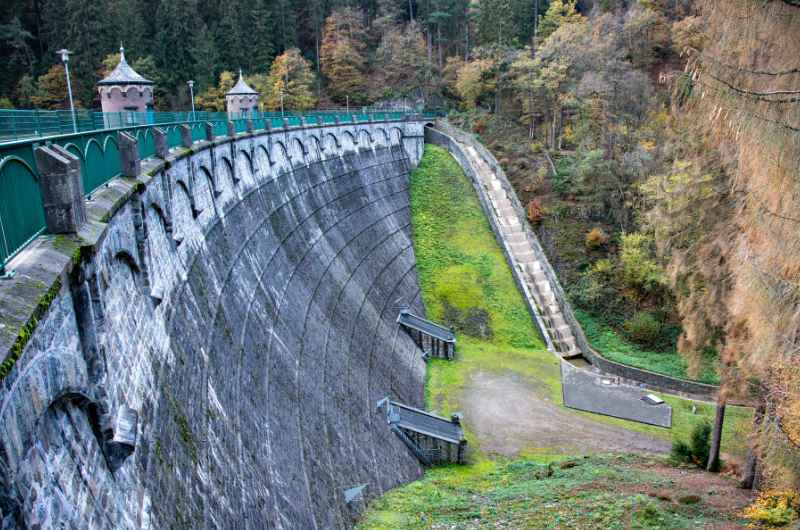
2. Arch Dams:
Arch dams are curved structures that resist water pressure. They transfer the pressure to the valley sides. They are mainly made of concrete. Arch dams are suited for narrow canyons or gorges, where the abutments can support the lateral thrust.
3. Buttress Dams:
Buttress dams are similar to gravity dams but have a series of many supports which are called buttresses. They are placed on the downstream side to resist the water pressure. These dams are commonly used in locations with softer foundation materials.
4. Embankment Dams:
Also known as earth fill dams, embankment dams are constructed using compacted earth, rock, sand, and sometimes concrete. They are built in areas where the foundation and abutments are suitable for supporting the weight of the dam.
5. Arch-Gravity Dams:
Arch-gravity dams combine the characteristics of both arch and gravity dams, using the arch shape to transfer some of the water pressure to the abutments while relying on their weight to resist the remaining pressure.
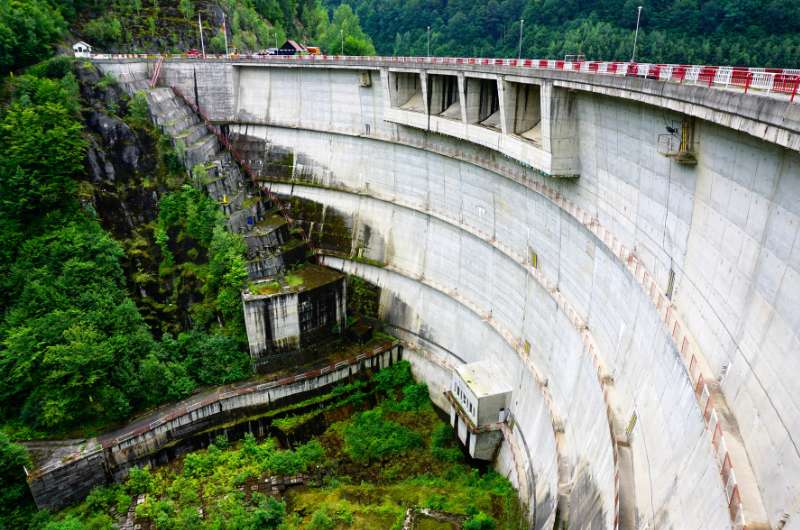
These are the types of famous dams in India, based on their specific design and construction.
Importance of Rivers and Dams in India
India is a country full of rivers. Rivers and dams in India play a significant role in the country’s development and growth in several ways. Most of them are discussed here:
1. Water Management:
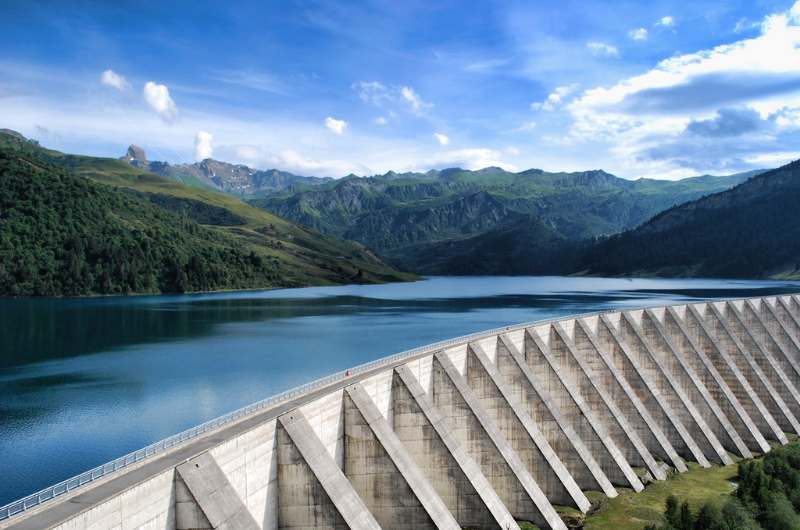
Dams help in the management and conservation of water resources. It is very crucial for agricultural, industrial, and domestic use. They store water during the rainy season and release it during the dry season. Dams provide a consistent water supply for irrigation and drinking purposes. Today, climate change is a concern for everyone. Dams can help fight against critical climate situations. Droughts and floods in India can easily be controlled by building dams.
2. Hydroelectric Power Generation:
Many dams in India are used for hydroelectric power generation, which is an essential source of renewable energy. It helps meet the increasing demand for electricity and reduces reliance on fossil fuels. Moreover, today, the world is heading towards a zero carbon policy. This pollution-free energy resource can help India towards a zero-carbon policy.
3. Flood Control:
Dams help mitigate the impact of floods by regulating the flow of water in rivers and preventing sudden peaks in water levels. These dams help in protecting low-lying areas and reducing the loss of life and property during floods.
4. Irrigation:
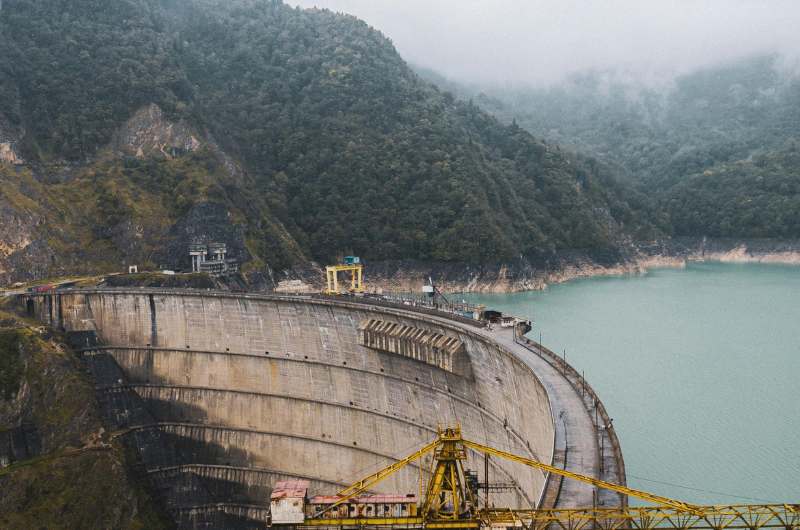
India is a country that depends on its agriculture for food. Dams provide water for irrigation to a large area of agricultural land. Dams increase crop productivity. It also contributes to food security in the country.
5. Tourism and Recreation:
Tourism is the backbone of many country’s economic growth. Many famous dams in India provide opportunities for tourism and many other recreational activities such as boating, fishing, and wildlife viewing, which contributes to local economies and the overall tourism industry.
Overall, dams in India play a crucial role in water management, energy generation, flood control, irrigation, and sustainable development, making them an essential part of the country’s infrastructure and economy.
List of Dams in India with River and State PDF
Here we have listed the rivers and dams in India in a table format. This Table has been listed according to the alphabetical order of state and rivers.
You can download the list of dams in India with river and state pdf from here.
List of Dams in India with River and State PDF: –
|
State |
Dam |
River |
|
Andhra Pradesh
|
Nagarjunasagar Dam |
Krishna |
|
Somasila Dam |
Pennar | |
|
Nizam Sagar Dam |
Manjira | |
|
Ramagundam |
Godavari | |
|
Srisailam Dam |
Krishna | |
|
Kalyani Dam |
Swarnamukhi | |
|
Veligallu Dam |
Papagni | |
|
Singur dam |
Manjira | |
|
Jalaput Dam (AP and Odisha Border) |
Machkund River | |
|
Tatipudi Reservoir |
Gosthani | |
|
Gandipalem Reservoir |
Pillaperu | |
|
Gandikota Reservoir |
Penna | |
|
Arunachal Pradesh |
Dibang |
Dibang |
|
Ranganadi |
Ranganadi | |
|
Bihar |
Nagi Dam |
Nagi River |
|
Chhattisgarh |
Dudhawa dam |
Mahanadi |
|
Minimata Bango (Hasdeo) |
Hasdeo | |
|
Gangreal Dam (R.S. Sagar) |
Mahanadi | |
|
Kutaghat |
Kharang | |
|
Gujarat |
Sardar Sarovar Dam |
Narmada |
|
Ukai Dam |
Tapi | |
|
Dantiwada |
West Banas | |
|
Kandana |
Mahi | |
|
Kamleshwar |
Hiran | |
|
Dharoi |
Sabarmathi | |
|
Dholidhaja |
Bhogavo | |
|
Karjan dam |
Karjan | |
|
Himachal Pradesh
|
Bhakra Nangal Dam |
Sutlej |
|
Maharana Pratap Sagar Reservoir/Pong Dam Lake |
Beas River | |
|
NathpaJakhri Dam |
Sutlej | |
|
Pong Dam |
Beas | |
|
Gobind Sagar Reservoir |
Sutlej | |
|
Pandoh Dam |
Beas | |
|
Chamera Dam |
Ravi | |
|
Koldam |
Sutlej | |
|
Kishau |
Tons | |
|
Jammu and Kashmir |
Salal Dam |
Chenab |
|
Uri Dam |
Jhelum | |
|
Baglihar Dam |
Chenab | |
|
Cholal Dam |
Cholal Choe | |
|
Chutak Hydroelectric Plant |
Suru | |
|
Nimoo Bazgo Hydroelectric Plant |
Indus | |
|
Jharkhand |
Panchet |
Damodar |
|
Maithon |
Barakar | |
|
Konar Dam |
Konar | |
|
Tenughat |
Damodar | |
|
Chandil |
Subarnarekha | |
|
Karnataka
|
Tunga Bhadra |
Thunga Bhadra |
|
Krishnaraja Sagar |
Kaveri | |
|
Basava Sagar Dam( Narayanpur) |
Krishna | |
|
Almatti |
Krishna | |
|
Bhadra |
Bhadra | |
|
Hemavathi |
Hemavathi | |
|
Hidkal |
Ghataprabha | |
|
Malaprabha |
Malaprabha | |
|
Linganamakki |
Sharavathi | |
|
Supa |
Kalinadi (Kali) River | |
|
Lakhya |
Lakya | |
|
Kodasalli Dam |
Kali | |
|
Ghataprabha Reservoir |
Ghataprabha | |
|
Hemavathi Reservoir |
Hemavathi | |
|
Kerala |
Cheruthoni |
Periyar river |
|
Idukki Arch Dam |
Periyar | |
|
Walayar |
Walayar | |
|
Kulamavu |
Kaliyar | |
|
Idamalayar |
Edamalayar/ Periyar | |
|
Kakki |
Kakki | |
|
Mullai periyar |
Periyar | |
|
Neyyar Dam |
Neyyar | |
|
Parambikulam |
Parambikulam | |
|
Banasura Sagar |
Kabini | |
|
Malampuzha |
Malampuzha | |
|
Ladakh |
Dumkar Hydroelectric Dam |
Indus |
|
Madhya Pradesh |
Indira Sagar Dam |
Narmada |
|
Gandhi Sagar Dam |
Chambal | |
|
Bansagar |
Son | |
|
Rajghat |
Betwa | |
|
Madikheda Dam |
Sindh River | |
|
Omkareshwar |
Narmada | |
|
Tawa |
Tawa | |
|
Bargi |
Narmada | |
|
Maharashtra
|
Koyna |
Koyna River |
|
Ujjani |
Bhima | |
|
Bhatsa |
Bhatsa& Chorna River | |
|
Isapur Dam |
Penganga | |
|
Jayakwadi (Paithan) |
Godavari | |
|
Totladoh |
Pench | |
|
Warna |
Warna | |
|
Yeldari |
Purna | |
|
Mulshi |
Mula | |
|
Panshet |
Ambi | |
|
Girna |
Girna and Godavari River | |
|
Radhanagiri |
Bhogawati | |
|
Khadakwasla |
Mutha | |
|
Gangapur Dam |
Maharashtra | |
|
Vaitarna |
Vaitarna | |
|
Odisha |
Hirakud |
Mahanadi |
|
Indravati |
Indravati | |
|
Mandira |
Sankh | |
|
Muran |
Muran | |
|
Rengali |
Brahmni | |
|
Kapur |
Kapur | |
|
Upper Kolab |
Kolab | |
|
Podagada |
Podagada | |
|
Balimela Reservoir |
Sileru | |
|
Punjab |
Bakhra Nangal Dam |
Bakhra Nangal |
|
Ranjit Sagar (Thein) Dam |
Ranjit Sagar (Thein) | |
|
Siswan Dam |
Siswan | |
|
Damsal Dam |
Damsal | |
|
Rajasthan
|
Jawahar Sagar |
Chambal |
|
Rana Pratap Sagar Dam |
Chambal | |
|
Mahai Bajaj Sagar Dam |
Mahi | |
|
Bisalpur |
Banas | |
|
Jawai |
Jawai/ Luni | |
|
Tamilnadu |
Mettur Dam |
Cauvery River |
|
Bhavani Sagar |
Bhavani River | |
|
Aliyar |
Aliyar | |
|
Amaravathi |
Amaravathi | |
|
Sholaiyar |
Sholaiyar | |
|
Vaigai |
Vaigai | |
|
Chittar |
Chittar | |
|
Pechiparai |
Kodayar | |
|
Manimuthar |
Manimuthar | |
|
Perunchani |
Paralayar | |
|
Telangana |
Srisailam |
Krishna |
|
NizamSagar |
Manjira | |
|
SriramSagar |
Godavari | |
|
Dindi Reservoir |
Krishna | |
|
Ramagundam |
Godavari | |
|
Singur |
Manjira | |
|
Somasila |
Pennar | |
|
Manair |
Manair | |
|
Uttar Pradesh |
Govind Ballabh Pant /Rihand Dam |
Rihand |
|
Rajghat |
Betwa | |
|
Matatila |
Betwa | |
|
Dhanraul |
Ghaghar | |
|
Parichha |
Betwa | |
|
Uttarakhand |
Tehri |
Bhagirathi |
|
Dhauli Ganga |
Dhauli Ganga River | |
|
Ramganga |
Ramganga | |
|
Lakhwar |
Yamuna | |
|
Koteshwar |
Bhagirathi | |
|
West Bengal |
Farakka barrage |
Ganga |
|
Panchet Dam |
Damodar | |
|
Kangsabati |
Kangsabati |
List of PDF link here-
Interesting Facts on Important Dams in India
- Largest Dam in India is Sardar Sarovar Dam.
- Highest Dam in India is Tehri Dam.
- First Dam in India is Kallanai Dam or Grand Anicut.
- Smallest Dam in India Pillur Dam in Tamil Nadu.
- Highest Gravity Dam in India is Tehri Dam.
- Longest Dam in India is Hirakud Dam.
Conclusion
In conclusion, the list of dams in India with river and state details in PDF format is essential in the context of your upcoming examinations. Dams hold a significant role in India’s water resource management and infrastructure development. India is a nation marked by diverse geographical features and a network of rivers. Understanding the distribution and characteristics of these dams becomes crucial for various purposes, particularly in the realm of competitive exams and broader national planning.
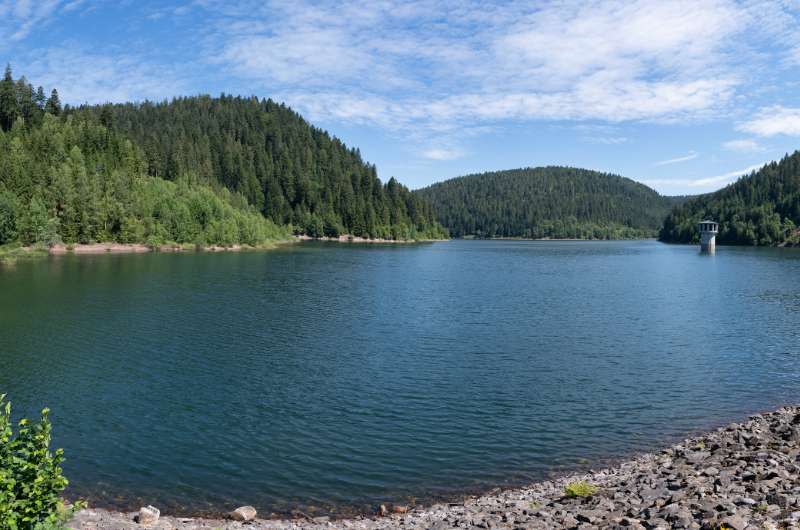
For India, where agriculture is a primary economic driver, dams play a pivotal role in irrigation. It ensures water availability for crops throughout the year. Additionally, the hydroelectric power generated by these dams contributes significantly to the country’s energy needs, fostering sustainable development. The details provided in the PDF offer a consolidated overview of the nation’s water infrastructure, aiding policymakers, researchers, and engineers in making informed decisions about water allocation, flood control, and power generation.
Significance of Famous Dams of India in Exams
In the context of competitive exams, where knowledge about India’s geography, infrastructure, and environmental concerns is essential, the list of dams in India proves to be a valuable resource. Aspiring candidates preparing for exams such as the Civil Services, Engineering Services, and state-level public service exams can benefit from a comprehensive understanding of these dams. Questions related to the rivers on which dams are constructed, their states, and their significance often feature prominently in such examinations.
Moreover, the PDF document serves as a quick reference guide, facilitating efficient and focused preparation. It enables exam candidates to grasp the geographical distribution of dams, understand the river basins, and appreciate the interconnectedness of India’s water resources. This knowledge is not only instrumental for securing high scores in exams but also for fostering a great understanding of the country’s infrastructural landscape.
In the broader national context, the list of dams in India is a testament to the nation’s commitment to harnessing its natural resources for the benefit of its people. It reflects the engineering prowess and strategic planning that have gone into creating a robust network of dams to address various societal needs. As India continues to evolve, ensuring sustainable water management and infrastructure development remains a crucial priority, making this topic not only relevant for exams but also integral to the nation’s progress. In conclusion, the list of dams in India with river and state details encapsulates the synergy between natural resources, engineering ingenuity, and strategic planning. Its significance extends beyond exam preparation to encompass the broader narrative of India’s journey toward sustainable development and effective water resource utilization.
==========
Thanks for reading this article. If you have any information related to this article and blog, you can put comment or visit the contact us page.
You can also visit the Disease, and Treatment-related Medical Blog: Nursing Knowledge
and Popular Quotation related Blog: A to Z Quotes
==========
The First Dam in India Built on Which River?
The first dam in India is believed to be the Kallanai Dam, also known as the Grand Anicut. It is the oldest dam in India. It was built across the Kaveri River in the state of Tamil Nadu by the Chola king Karikalan around the 2nd century AD. The Kallanai Dam is one of the oldest water-diversion or water-regulator structures in the world and is still in use for irrigation purposes.
Which is the Smallest Dam in India?
The Pillur Dam, located in the Coimbatore district of Tamil Nadu, is considered to be the smallest dam in India. It is a small masonry dam built across the Pillur River, a tributary of the Bhavani River. This dam primarily serves as a water supply and irrigation source for the surrounding agricultural lands. Its small size and capacity make it the smallest dam in India. The capacity of this dam is 52 lakh litres.It is divided into two compartments
What is the name of Highest Gravity Dam in India?
The highest gravity dam in India is the Tehri Dam. It is located on the River Bhagirathi in the state of Uttarakhand. It is one of the tallest dams in the world and stands at the height of 260.5 meters (855 feet), and has a capacity of 2,400 MW of electricity generation. The dam is a significant hydropower and water resource project in India, and its construction was completed in 2006.
Which is the Largest Dam in India?
The largest dam in India is the Sardar Sarovar Dam. It is located on the Narmada River in the state of Gujarat. It is a concrete gravity dam and stands at a height of 163 meters (535 feet). The Sardar Sarovar Dam is also one of the largest dams in the world in terms of volume and concrete used in its construction. This multipurpose dam provides water for irrigation, drinking water, and hydroelectric power generation.
Which is the Longest Dam in India?
Hirakud Dam on Mahanadi river is marked as the longest dam in India. This Dam is located in Odisha and spans the Mahanadi River. The dam is about 26 kilometers (16 miles) in length and was completed in 1957. Hirakud Dam was constructed for flood control, irrigation, and hydroelectric power generation.
Which is the Highest Dam of India?
The Tehri Dam is the highest dam in India. It is located in the state of Uttarakhand. It is a multipurpose rock and earth-fill embankment dam on the Bhagirathi River and stands at a height of 260.5 meters (855 feet). The dam was completed in 2006 and serves purposes like hydroelectric power generation, irrigation, and water supply.

